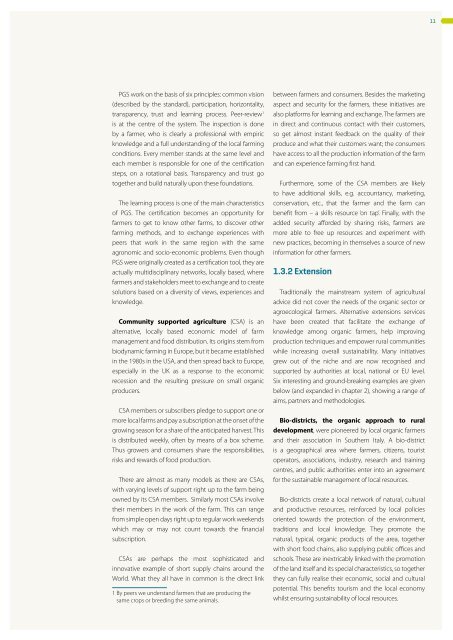tpo_dossier_action-plan-for-innovation-and-learning_201406
tpo_dossier_action-plan-for-innovation-and-learning_201406
tpo_dossier_action-plan-for-innovation-and-learning_201406
You also want an ePaper? Increase the reach of your titles
YUMPU automatically turns print PDFs into web optimized ePapers that Google loves.
11PGS work on the basis of six principles: common vision(described by the st<strong>and</strong>ard), participation, horizontality,transparency, trust <strong>and</strong> <strong>learning</strong> process. Peer-review 1is at the centre of the system. The inspection is doneby a farmer, who is clearly a professional with empiricknowledge <strong>and</strong> a full underst<strong>and</strong>ing of the local farmingconditions. Every member st<strong>and</strong>s at the same level <strong>and</strong>each member is responsible <strong>for</strong> one of the certificationsteps, on a rotational basis. Transparency <strong>and</strong> trust gotogether <strong>and</strong> build naturally upon these foundations.The <strong>learning</strong> process is one of the main characteristicsof PGS. The certification becomes an opportunity <strong>for</strong>farmers to get to know other farms, to discover otherfarming methods, <strong>and</strong> to exchange experiences withpeers that work in the same region with the sameagronomic <strong>and</strong> socio-economic problems. Even thoughPGS were originally created as a certification tool, they areactually multidisciplinary networks, locally based, wherefarmers <strong>and</strong> stakeholders meet to exchange <strong>and</strong> to createsolutions based on a diversity of views, experiences <strong>and</strong>knowledge.Community supported agriculture (CSA) is analternative, locally based economic model of farmmanagement <strong>and</strong> food distribution. Its origins stem frombiodynamic farming in Europe, but it became establishedin the 1980s in the USA, <strong>and</strong> then spread back to Europe,especially in the UK as a response to the economicrecession <strong>and</strong> the resulting pressure on small organicproducers.CSA members or subscribers pledge to support one ormore local farms <strong>and</strong> pay a subscription at the onset of thegrowing season <strong>for</strong> a share of the anticipated harvest. Thisis distributed weekly, often by means of a box scheme.Thus growers <strong>and</strong> consumers share the responsibilities,risks <strong>and</strong> rewards of food production.There are almost as many models as there are CSAs,with varying levels of support right up to the farm beingowned by its CSA members. Similarly most CSAs involvetheir members in the work of the farm. This can rangefrom simple open days right up to regular work weekendswhich may or may not count towards the financialsubscription.CSAs are perhaps the most sophisticated <strong>and</strong>innovative example of short supply chains around theWorld. What they all have in common is the direct link1 By peers we underst<strong>and</strong> farmers that are producing thesame crops or breeding the same animals.between farmers <strong>and</strong> consumers. Besides the marketingaspect <strong>and</strong> security <strong>for</strong> the farmers, these initiatives arealso plat<strong>for</strong>ms <strong>for</strong> <strong>learning</strong> <strong>and</strong> exchange. The farmers arein direct <strong>and</strong> continuous contact with their customers,so get almost instant feedback on the quality of theirproduce <strong>and</strong> what their customers want; the consumershave access to all the production in<strong>for</strong>mation of the farm<strong>and</strong> can experience farming first h<strong>and</strong>.Furthermore, some of the CSA members are likelyto have additional skills, e.g. accountancy, marketing,conservation, etc., that the farmer <strong>and</strong> the farm canbenefit from – a skills resource ‘on tap’. Finally, with theadded security af<strong>for</strong>ded by sharing risks, farmers aremore able to free up resources <strong>and</strong> experiment withnew practices, becoming in themselves a source of newin<strong>for</strong>mation <strong>for</strong> other farmers.1.3.2 ExtensionTraditionally the mainstream system of agriculturaladvice did not cover the needs of the organic sector oragroecological farmers. Alternative extensions serviceshave been created that facilitate the exchange ofknowledge among organic farmers, help improvingproduction techniques <strong>and</strong> empower rural communitieswhile increasing overall sustainability. Many initiativesgrew out of the niche <strong>and</strong> are now recognised <strong>and</strong>supported by authorities at local, national or EU level.Six interesting <strong>and</strong> ground-breaking examples are givenbelow (<strong>and</strong> exp<strong>and</strong>ed in chapter 2), showing a range ofaims, partners <strong>and</strong> methodologies.Bio-districts, the organic approach to ruraldevelopment, were pioneered by local organic farmers<strong>and</strong> their association in Southern Italy. A bio-districtis a geographical area where farmers, citizens, touristoperators, associations, industry, research <strong>and</strong> trainingcentres, <strong>and</strong> public authorities enter into an agreement<strong>for</strong> the sustainable management of local resources.Bio-districts create a local network of natural, cultural<strong>and</strong> productive resources, rein<strong>for</strong>ced by local policiesoriented towards the protection of the environment,traditions <strong>and</strong> local knowledge. They promote thenatural, typical, organic products of the area, togetherwith short food chains, also supplying public offices <strong>and</strong>schools. These are inextricably linked with the promotionof the l<strong>and</strong> itself <strong>and</strong> its special characteristics, so togetherthey can fully realise their economic, social <strong>and</strong> culturalpotential. This benefits tourism <strong>and</strong> the local economywhilst ensuring sustainability of local resources.


